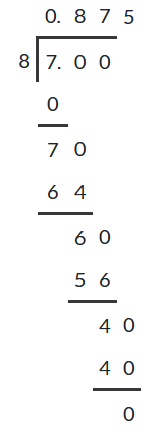Convert any fraction to decimal number: this fraction calculator computes the decimal and percent equivalents of a fraction.
Rate this calculator
How to use the Fraction to Decimal Calculator?
Time needed: 1 minute
- Enter the Fraction
Write the Numerator of the fraction into the top field.
Write the Denominator of the fraction into the bottom field. - Press the Calculate button
Press the Calculate button below the fraction fields.
- Review the Output
The results will appear in the Output field.
- Copy or Save the result
Optionally, you can Copy the output to clipboard, or Save it as a file on your device.
Calculator features
| 🔢 Result Format: | Decimal, Percent |
| ⚡ Speed of Computation: | Instant! |
| ➡️ Calculator Output: | Display, Copy, Save |
| 🎯 Calculator Accuracy: | 100% |
| 📋 Definitions and Formulas: | Available |
What is a Fraction?
In math, a fraction is the quotient of the numerator divided by the denominator.
Fractions are represented by two numbers stacked vertically with a line in the middle. The line represents a division. The top number is the numerator, and the bottom number is the denominator.
A fraction represents a number of parts out of the total number of parts.
How to convert Fraction to Decimal
Division Method
The simplest method is the Division method: since a fraction represents a division, all you have to do is to divide the numerator number by the denominator number. The result of the division will be the decimal form of the fraction.
This is the easiest method if you have a calculator available.
Example: let’s take the fraction ¼.
We simply divide the fraction’s numerator (1) by the fraction’s denominator (4). In this case, 1 ÷ 4 = 0.25
Long division Method
If you don’t have a calculator at hand, you can use the long division method, where the fraction’s numerator is the dividend and the fraction’s denominator is the divisor.
Then simply solve the long division to convert the fraction to decimal.
Example: let’s use the long division method to convert the fraction ⅞:
In this case the dividend is 7 and the divisor is 8.

Simplification Method
This alternative method involves simplifying the fraction by multiplying the fraction’s denominator to get a power of 10, like 10, 100, 1000 and so on, and then multiply the fraction’s numerator by the same multiplier.
Example: let’s take the fraction ¾.
We can convert the bottom of the fraction to 100 (which is a power of 10) by multiplying it by 25.
We will also multiply the top of the fraction by the same multiplier: 3 x 25 = 75.
The result is 75 / 100. We then divide the numerator by the denominator to get the result: 75 / 100 = 0.75
Common fractions to decimal conversion table
| Fraction | Decimal |
|---|---|
| 1/2 | 0.5 |
| 1/3 | 0.33333333 |
| 2/3 | 0.66666667 |
| 1/4 | 0.25 |
| 2/4 | 0.5 |
| 3/4 | 0.75 |
| 1/5 | 0.2 |
| 2/5 | 0.4 |
| 3/5 | 0.6 |
| 4/5 | 0.8 |
| 1/6 | 0.16666667 |
| 2/6 | 0.33333333 |
| 3/6 | 0.5 |
| 4/6 | 0.66666667 |
| 5/6 | 0.83333333 |
| 1/7 | 0.14285714 |
| 2/7 | 0.28571429 |
| 3/7 | 0.42857143 |
| 4/7 | 0.57142858 |
| 5/7 | 0.71428571 |
| 6/7 | 0.85714286 |
| 1/8 | 0.125 |
| 2/8 | 0.25 |
| 3/8 | 0.375 |
| 4/8 | 0.5 |
| 5/8 | 0.625 |
| 6/8 | 0.75 |
| 7/8 | 0.875 |
| 1/9 | 0.11111111 |
| 2/9 | 0.22222222 |
| 3/9 | 0.33333333 |
| 4/9 | 0.44444444 |
| 5/9 | 0.55555556 |
| 6/9 | 0.66666667 |
| 7/9 | 0.77777778 |
| 8/9 | 0.88888889 |
| 1/10 | 0.1 |
| 2/10 | 0.2 |
| 3/10 | 0.3 |
| 4/10 | 0.4 |
| 5/10 | 0.5 |
| 6/10 | 0.6 |
| 7/10 | 0.7 |
| 8/10 | 0.8 |
| 9/10 | 0.9 |
